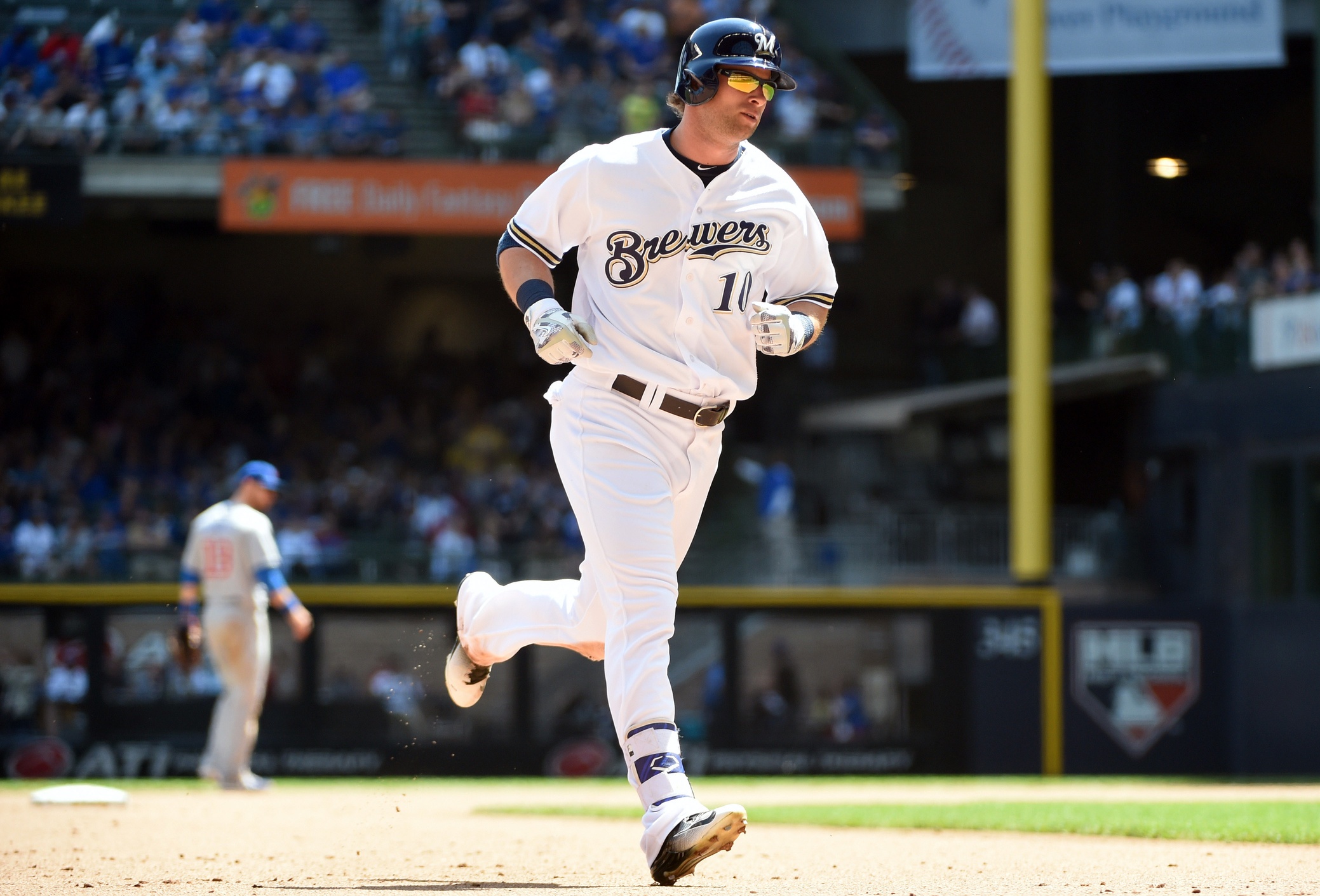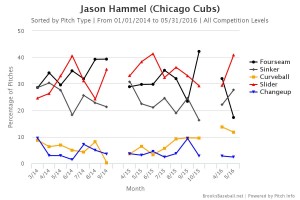Top Play (WPA): In the culmination of a frustrating series for the Cubs (frustrating for both teams, really), the Cubs’ top play came on the second pitch of the game. Before the sizable crowd of Cubs fans settled into their Miller Park seats, Dexter Fowler sent a rocket into the right-field bleachers off of Junior Guerra (+0.098). Guerra went on to stifle the Cubs’ offense—as Chase Anderson and Jimmy Nelson did before him—for seven innings, leaving with a 4-2 lead.
Guerra’s splitter was his best pitch of the afternoon, and he made some Cubs hitters look foolish at the plate, which is not an easy thing to do. His 11 strikeouts are the most an opposing starter has racked up against the Cubs this year; starters just haven’t found their way into the late innings against them often, but Guerra succeeded.
Bottom Play (WPA): If this recap were a rap single, this would be the killer guest verse. Here’s Travis Sarandos of BP Milwaukee.
The Brewers have shown a special kind of aversion to plating runners in scoring position this season. We saw it last night/early this morning when, sandwiched between a bases loaded walk issued to pitcher Travis Wood, the Brewers failed on three separate occasions in the final two innings to score a runner on third base with less than two outs. Though they’ve had the sixth most such opportunities this season entering play today, their 43 percent rate of scoring that runner ranks 25th, and has contributed to the Brewers scoring at a below-league average rate. That, despite ranking in the top ten in on base percentage.
We didn’t see much of that issue today, because the Brewers realized that putting runners in scoring position is actually an unnecessary step when you can just pound dingers over the fence. Following a Scooter Gennett single to left (and a Chris Carter strikeout), that’s just what Kirk Nieuwenhuis did, breaking a 2-2 tie in the sixth with a two run shot into the picnic area behind right field (-0.257 WPA). It was only his second home run of the season and, though he’s not provided a lot of power, Nieuwenhuis has been one of Milwaukee’s steadiest offensive producers this season thanks in part to a career high 16.7 percent walk rate. He absolutely refuses to swing at balls, with an O-Swing percentage of 14.2 percent that would easily be the lowest in the league if he had the plate appearances to qualify. Having captured the everyday gig in centerfield, I would expect him to begin appearing on the official leaderboards soon.
It’s not Chance on “Ultralight Beam,” Travis, but it’ll do.
Key Moment: After a tough go against Guerra, the Cubs found themselves squaring off against Michael Blazek in the eighth. Blazek got two quick outs from Jason Heyward and Kris Bryant before walking Anthony Rizzo. The red-hot Ben Zobrist followed with an opposite-field double, putting two runners in scoring position for Jorge Soler.
Soler had doubled early in the game, and hustled around third to score on a Miguel Montero single to left, capping a good baserunning series for the outfielder. He worked Blazek to a 3-0 count, and with first base open and Addison Russell on deck, there was reason to believe that Blazek might just put Soler on base. Alas, he did not: Soler took two strikes in a row, including a 3-1 breaking ball that just graced the top of the zone, before striking out swinging and ending the Cubs’ threat.
As they had done the two previous nights, the Cubs threatened in the ninth. Brewers pitcher Tyler Thornburg, filling in as closer for the overworked Jeremy Jeffress, couldn’t find the strike zone—he walked Russell and Montero to lead off the inning, before he got pinch-hitter Javier Baez to strike out. Unfortunately, even with Thornburg missing the zone badly, Baez appeared to be in “automatic swing” mode. Fowler flew deep to right, advancing Russell to third, but Jason Heyward couldn’t connect against Thornburg, who struck out the Cubs’ right fielder and ended a tense three-game set.
Trend to Watch: Jason Hammel gave up two home runs on the day, tripling his season total (which now rests at three). Keeping opponents in the park has been key to his early success, and his single home run allowed in 40 2/3 innings led major-league starters. The other key factor in his success so far has been a ground ball rate significantly better than his career average. Going into this game, he generated 50 percent ground balls in 2016, compared to his marks around 40 percent the past three seasons.
That right might actually be sustainable, if his pitch selection trends continue. This month, Hammel has eschewed his four-seam fastball for his sinker and slider—pitches that induce groundballs. That usage reflects his usage from last season’s first half, a very successful half for Hammel.
The primary difference between Hammel’s 2016 and his previous two seasons is his increased reliance on his curveball, which might have an effect on his slider’s efficacy in generating groundballs. Hammel’s pitch mix is certainly something to keep an eye on going forward, as is his locating of those pitches.
Coming Next: Dropping two against the Brewers is a disappointing outcome, and the Cubs will look to wash the taste of this series from their mouths as they travel west to San Francisco. Friday night, in the city famous for its Chinatown, we get The Two Jakes: Jake Arrieta (1.29 ERA, 85 cFIP, 3.30 DRA) faces Jake Peavy (7.42, 111, 5.87). The former struck out 11 and allowed only three hits in eight innings last start against Pittsburgh, and Peavy has been bad this season, evinced by his ERA and DRA, so it could be a correction of course for the scuffling Cubs offense. Andrew Felper will have the series preview Friday morning. Stock up on espresso after work: first pitch is 9:15 Central on WGN.
Lead photo courtesy Benny Sieu—USA Today Sports.

